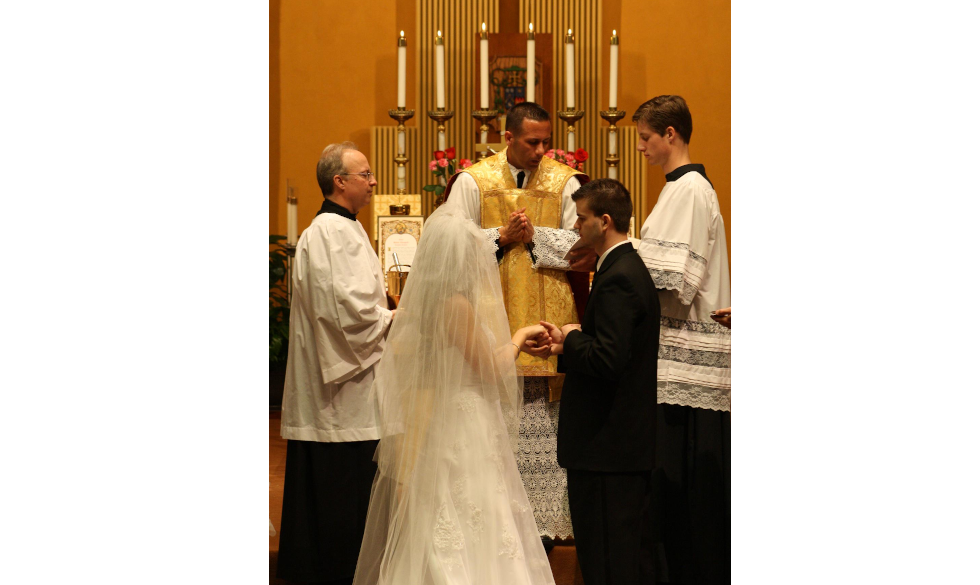One question that I hear from time to time asked is what is the difference between contraception and Natural Family Planning? (NFP) Are the two equivalent from a moral perspective? Obviously they differ in the approach to preventing pregnancy. Not only that, NFP can be used as a means for a woman to get pregnant rather than avoid pregnancy.
First some preliminaries: Most people know that the Catholic Church teaches that both sterilization and the use of contraceptives are unlawful. This was clearly laid out in an encyclical letter which Pope Paul VI promulgated in 1968 called “Humanae Vitae”.
This encyclical opens addressing many of the issues and concerns of these times such as difficulties married couples can face, technological advances and rapid population growth, however it points out:
In considering the problem of birth regulation, as in the case of every other problem regarding human life, one must look beyond partial perspectives-whether biological or psychological, demographic or sociological-and make one’s consideration in the light of an integral vision of man and of his vocation, not only his natural and earthly vocation, but also his supernatural and eternal one.1
Pope Paul goes on to state that the love between husband and wife is total, faithful and exclusive until death, and is fruitful. On this fruitfulness he writes:
...for it is not exhausted by the communion between husband and wife but is destined to perpetuate itself, bringing new lives into existence. ‘Marriage and conjugal love are by their nature ordained to the begetting and rearing of children. Indeed, children are the most precious gift of marriage and contribute immensely to the good of the parents themselves.’2
Regarding the nature of the conjugal act between husband and wife, it is both unitive (a renewal of the marriage covenant that binds them together) and procreative. And these two aspects are inseparable.
This teaching, set forth by the Magisterium on numerous occasions, is founded upon the inseparable connection, willed by God and which man may not break on his own initiative, between the two-fold significance of the conjugal act: the unitive significance and the procreative significance.
Indeed, by its intimate structure, the conjugal act, while closely uniting husband and wife, makes them apt for the generation of new lives, according to laws inscribed in the very being of man and woman. By safeguarding both these essential aspects, the unitive and the procreative, the conjugal act preserves in its fullness the sense of true mutual love and its ordination to man’s most high vocation to parenthood. We think that men of our day are particularly capable of confirming the deeply reasonable and human character of this fundamental principle.3
Currently both the Church and secular society are at odds over this issue. The Church teaches us that sex is a means to an end and that there are restraints to its use. It is subordinate to and serves a greater good – procreation and union within sacramental marriage. The culture at large wants us to believe sex is an end in and of itself - there should be no constraints to sex. This not only separates the unitive from the procreative but the sexual act can become separated from both and simply become something that is “stand alone” as seen in hook ups and one night stands.
When sex becomes “the end” in a culture there are several logical outcomes that emerge, and which have become increasingly evident since the late 1960s and 1970s. I would call this a “contraceptive mentality”.
First, pregnancy will be a frequent unwanted “side effect” unless means are used to prevent this, so contraception must be used. However that is not enough. Contraceptives are not perfect, nor are people diligent in using contraceptives so “accidents” happen. Thus abortion is needed as a back up, or another “solution” is the abortion pill RU-486.4 This is why abortion and contraception have been called “twin sisters”.
Second, marriage and family become irrelevant. Co-habitation, serial relationships, same sex marriage, even polygamy and pederasty are acceptable. Within the moral framework of sex being an end in itself, there are no logical arguments against these behaviors.
Third, when sex is separated from reproduction, reproduction becomes separated from sex. Thus practices like artificial insemination and in vitro fertilization (IVF) become common. The problem with the latter is that there are now hundreds of thousands of embryos “on ice”. These are human beings with souls that are in a form of suspended animation, being stored in liquid nitrogen. They are redundant because with IVF a surplus of these human embryos need to be produced due to the fact that this procedure has a low success rate of less than 30% per cycle.5 (The big difference between an IVF cycle and a regular menstrual cycle is that ovulation does not take place in an IVF cycle. Instead, the eggs are retrieved at the point of maturation and are fertilized in the IVF lab to create embryos.6)
So what about Natural Family Planning or NFP in short? What exactly is it?
Here is a definition: “Systematic NFP consists of various ‘methods’ or systems that seek to determine the fertile and infertile times of the cycle.” The couple may “use a cross-checking system called the Sympto-Thermal Method (STM). It uses all the common signs of fertility in a cross-checking way. Another common system focuses primarily on the mucus sign and is frequently called the ‘Ovulation Method.’ Some couples use a temperature-only form of NFP, and some use the cervix sign in combination with either the temperature sign or the mucus sign.”7
NFP acts prior and by its very nature acknowledges the power of sex to create new life and, rather than separating the unitive and procreative in the sexual act, it places restraints on the couple, inherently making them acknowledge and accommodate the procreative power of sex. They must accept that there are times when sex may result in conception and work around these times if they wish to avoid pregnancy. This requires self control. This prevents those using it from falling into this “contraceptive mentality”.
The use of NFP shifts the solution to the problem of avoiding conception from being one of relying on a mechanical or chemical solution to work after the sexual act, allowing the couple to forget about any consequences of sex beyond the moment, to one in which they must acknowledge that there is something marvelous about sex, something that is bigger than themselves, which cannot be ignored, and must be accommodated because it can result in a new human being nine months from that point – an outcome that has eternal consequences.
Let’s return to “Humanae Vitae” and see what it says. I will give this document the last word:
If, then, there are serious motives for spacing births, motives deriving from the physical or psychological condition of husband or wife, or from external circumstances, the Church teaches that it is then permissible to take into account the natural rhythms immanent in the generative functions and to make use of marriage during the infertile times only, and in this way to regulate births without offending the moral principles that we have just recalled.8
Pope Paul VI is quite explicit and goes on to write:
The Church is consistent when she considers recourse to the infertile times to be permissible, while condemning as being always wrong the use of means directly contrary to fertilization, even if such use is inspired by reasons that can appear upright and serious. In reality, there is an essential difference between the two cases. In the first case the husband and wife legitimately avail themselves of a natural condition; in the second case, they impede the working of natural processes. It is true that in both cases the married couples agree in positively willing to avoid children for plausible reasons, seeking to be certain that offspring will not result; but it is likewise true that only in the first case do they prove able to abstain from the use of marriage during the fertile times, when for proper motives procreation is not desirable, then making use of it during the infertile times to manifest affection and to safeguard mutual fidelity. By so doing, the give proof of a love that is truly and fully virtuous.9
1. Humanae Vitae, Encyclical Letter of His Holiness Pope Paul VI, Ignatius Press, San Francisco, 1978, Paragraph 7, P. 8.
2. Ibid, Paragraph 9, P. 9.
3. Ibid, Paragraph 12, P. 11.
4. An interesting anecdote about the abortion pill name “RU-486” also known as “mifeprestone”. The proper pronunciation of this name “RU-486” sounds like the phrase “Are you for eighty-six?” the definition of eighty-six can be found here: https://en.wikipedia.org/wiki/86_(term) At the time of this article this is what the lead in to the wiki article was: “Eighty-six or 86 is American English slang used to indicate that an item is no longer available, traditionally from a food or drinks establishment; or referring to a person or people who are not welcome in the premises. Its origins are unknown but seem to have been coined in the 1920s or 1930s.
The term is now more generally used to get rid of someone or something. In the 1970s, its meaning expanded to refer to murder.”
5. Web MD, https://www.webmd.com/infertility-and-reproduction/guide/in-vitro-fertilization#3
6. Genetics and IVF Institute, https://www.givf.com/fertility/ivfcycleindetail.shtml
7. “Natural Family Planning, The Complete Approach”, John and Sheila Kippley, Chapter 1, 2010. This is on an excellent NFP resource website: www.nfpandmore.org
8. Humanae Vitae, Encyclical Letter of His Holiness Pope Paul VI, Ignatius Press, San Francisco, 1978, Paragraph 16, P. 14.
9. Ibid.






